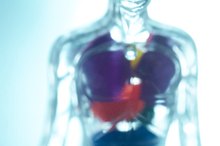Signs of Kidney Blockage
Normally, the kidneys function as part of the excretory system and help the body filter waste out of the blood, which is then excreted as urine. The kidneys also help maintain a healthy blood pressure level within the body by removing excess salt and water from the blood. If the kidney or arteries within the kidney become blocked, the kidneys could sustain permanent functional damage.
If you are experiencing serious medical symptoms, seek emergency treatment immediately.
Lower Back Pain
If one or both kidneys are blocked, you may begin to develop a dull aching pain within your lower back or abdominal area. Pain may be moderate to severe, depending upon the extent of kidney inflammation that occurs as a result of blockage. During an examination in a medical clinic, your doctor may tap your lower back with her hands, which can cause intense, sharp pain if you have blockage of one or both kidneys.
Blood in the Urine
Kidney's Function Related to the Circulatory System of the Human Body
Learn More
Some people who have a blocked kidney may notice blood in the urine. This symptom may cause your urine to appear orange or red in color.
Urinary Tract Infection
Kidney blockage can cause urine to build up within the kidney, which can lead to a urinary tract infection. Symptoms of a urinary tract infection include fever, pain during urination or a urinary urgency in some people. Some people may also experience pain in the lower back or abdomen. Typically a urinary tract infection requires antibiotic treatment to resolve symptoms associated with this condition.
- Kidney blockage can cause urine to build up within the kidney, which can lead to a urinary tract infection.
- Typically a urinary tract infection requires antibiotic treatment to resolve symptoms associated with this condition.
Weight Gain
What Are the Causes of a Swollen Kidney?
Learn More
Blockage of the kidneys prevents excess fluid from being excreted from the body. This can cause areas of the body, such as the feet, ankles or hands, to expand and swell with excess fluid. The "Merck Manual of Medical Information" notes that increased fluid retention can cause weight gain to occur in some people 2.
High Blood Pressure
Kidney blockage might prevent the kidneys from removing excess salt and water from the blood. This can make it harder for the heart to pump blood through the body and can cause high blood pressure to develop in certain people.
Flu-like Symptoms
Kidney infection might occur if the kidneys are blocked, a condition which can cause flu-like symptoms to occur in some people. Such symptoms include fever, body aches, nausea or vomiting.
Acute Kidney Failure
If the kidneys are completely blocked, urine production stops and causes the kidneys begin shutting down. If left untreated, this condition—called acute kidney failure—could lead to death in some cases.
Related Articles
References
- Medline Plus: Obstructive Uropathy
- The Merck Manual of Medical Information: Blockage of the Renal Arteries
- Dewar MJ, Chin JL. Chronic renal pain: An approach to investigation and management. Can Urol Assoc J. 2018;12(6 Suppl 3):S167-S170. doi:10.5489/cuaj.5327
- Akcay A, Turkmen K, Lee D, Edelstein CL. Update on the diagnosis and management of acute kidney injury. Int J Nephrol Renovasc Dis. 2010;3:129-40. doi:10.2147/IJNRD.S8641
- Belyayeva M, Jeong JM. Acute Pyelonephritis. StatPearls Publishing. Updated February 28, 2019.
- Venkatesh L, Hanumegowda RK. Acute Pyelonephritis - Correlation of Clinical Parameter with Radiological Imaging Abnormalities. J Clin Diagn Res. 2017;11(6):TC15-TC18. doi:10.7860/JCDR/2017/27247.10033
- Erlich T, Kitrey ND. Renal trauma: the current best practice. Ther Adv Urol. 2018;10(10):295-303. doi:10.1177/1756287218785828
- European Association of Urology. EAU Guidelines: Urological Trauma.
- Mujoomdar M, Russell E, Dionne F, et al. Suspected Obstructive Uropathy. Optimizing Health System Use of Medical Isotopes and Other Imaging Modalities [Internet]. Ottawa (ON): Canadian Agency for Drugs and Technologies in Health; 2012.
- Algaba F. Renal adenomas: pathological differential diagnosis with malignant tumors. Adv Urol. 2008;:974848. doi:10.1155/2008/974848
- Muglia VF, Prando A. Renal cell carcinoma: histological classification and correlation with imaging findings. Radiol Bras. 2015;48(3):166-74. doi:10.1590/0100-3984.2013.1927
- Harris PC, Torres VE. Polycystic Kidney Disease, Autosomal Dominant. In: Adam MP, Ardinger HH, Pagon RA, et al., editors. GeneReviews® [Internet]. Seattle (WA): University of Washington, Seattle. Updated July 19, 2018.
- Bukhari S, Amodu A, Akinyemi M, Wallach S. Persistent hematuria caused by renal cell carcinoma after aortic valve replacement and warfarin therapy. Proc (Bayl Univ Med Cent). 2017;30(3):327-329.
- Halvorson CR, Bremmer MS, Jacobs SC. Polycystic kidney disease: inheritance, pathophysiology, prognosis, and treatment. Int J Nephrol Renovasc Dis. 2010;3:69-83.
- Finnigan NA, Leslie SW. Polycystic Kidney Disease, Adult. StatPearls Publishing. Updated February 3, 2019.
- Chapman AB, Devuyst O, Eckardt KU, et al. Autosomal-dominant polycystic kidney disease (ADPKD): executive summary from a Kidney Disease: Improving Global Outcomes (KDIGO) Controversies Conference. Kidney Int. 2015;88(1):17-27. doi:10.1038/ki.2015.59
- Smith DA, Nehring SM. Bacteremia. StatPearls Publishing. Updated November 15, 2018.
- Westphalen AC, Hsia RY, Maselli JH, Wang R, Gonzales R. Radiological imaging of patients with suspected urinary tract stones: national trends, diagnoses, and predictors. Acad Emerg Med. 2011;18(7):699-707. doi:10.1111/j.1553-2712.2011.01103.x
- Gounden V, Jialal I. Renal Function Tests. StatPearls Publishing. Updated April 3, 2019.
- Gowda S, Desai PB, Kulkarni SS, Hull VV, Math AA, Vernekar SN. Markers of renal function tests. N Am J Med Sci. 2010;2(4):170-3.
- Louie RJ, Tonneson JE, Gowarty M, Goodney PP, Barth RJ, Rosenkranz KM. Complete blood counts, liver function tests, and chest x-rays as routine screening in early-stage breast cancer: value added or just cost? Breast Cancer Res Treat. 2015;154(1):99-103. doi:10.1007/s10549-015-3593-y
- Engelsgjerd JS, Deibert CM. Cystoscopy. StatPearls Publishing. Updated March 15, 2019.
- Elshazzly M, Bashjawish F, Shahid MA, Marrero DA, Horowitz J. A Challenging Case of Retroperitoneal Abscess in a Post-Partum Crohn's Disease Patient. Am J Case Rep. 2018;19:773-777. doi:10.12659/AJCR.909545
- Chi AC, Flury SC. Urology patients in the nephrology practice. Adv Chronic Kidney Dis. 2013;20(5):441-8. doi:10.1053/j.ackd.2013.05.002
- Mclellan LK, Hunstad DA. Urinary Tract Infection: Pathogenesis and Outlook. Trends Mol Med. 2016;22(11):946-957. doi:10.1016/j.molmed.2016.09.003
- Harbell J, Terrault NA, Stock P. Solid organ transplants in HIV-infected patients. Curr HIV/AIDS Rep. 2013;10(3):217-25. doi:10.1007/s11904-013-0170-z
- Sohail M, Khurshid M, Saleem HG, Javed H, Khan AA. Characteristics and Antibiotic Resistance of Urinary Tract Pathogens Isolated From Punjab, Pakistan. Jundishapur J Microbiol. 2015;8(7):e19272. doi:10.5812/jjm.19272v2
- Codjoe FS, Donkor ES. Carbapenem Resistance: A Review. Med Sci (Basel). 2017;6(1). doi:10.3390/medsci6010001
- Shoobridge JJ, Corcoran NM, Martin KA, Koukounaras J, Royce PL, Bultitude MF. Contemporary management of renal trauma. Rev Urol. 2011;13(2):65-72.
- Jo KI, Yang NR, Jeon P, Kim KH, Hong SC, Kim JS. Treatment Outcomes with Selective Coil Embolization for Large or Giant Aneurysms : Prognostic Implications of Incomplete Occlusion. J Korean Neurosurg Soc. 2018;61(1):19-27. doi:10.3340/jkns.2016.0101.018
- Dagli M, Ramchandani P. Percutaneous nephrostomy: technical aspects and indications. Semin Intervent Radiol. 2011;28(4):424-37. doi:10.1055/s-0031-1296085
- Li W, Cheng Y, Cheng Y, Ren H, Han N. Clinical efficacy of radical nephrectomy versus nephron-sparing surgery on localized renal cell carcinoma. Eur J Med Res. 2014;19:58. doi:10.1186/s40001-014-0058-4
- Guler S, Cimen S, Hurton S, Molinari M. Diagnosis and Treatment Modalities of Symptomatic Polycystic Kidney Disease. In: Li X, editor. Polycystic Kidney Disease [Internet]. Brisbane (AU): Codon Publications; 2015.
- Bonsib, S. Renal Cystic Diseases and Renal Neoplasms: A Mini-Review. Clin J Amer Soc Nephrol. 2009:4(12):1998-2007. DOI: 10.2215/CJN.02020309.
- Castner, D. A closer look at pyelonephritis. Nursing 2013. 2013;43(10):63. DOI: 10.1097/01.NURSE.0000434322.10150.26.
- Mourmourisa, P.; Chiras, T; and Papatsoris, A. Obstructive Uropathy: From Etiopathology to Therapy. World J Nephrol Urol. 2014;3(1):1-6. DOI: 10.14740/wjnu154w.
- Shoobridge, J.; Corcoran, N.; Martin, K. et al. Contemporary Management of Renal Trauma. Rev Urol. 2011;13(2):65-72.
Writer Bio
Rae Uddin has worked as a freelance writer and editor since 2004. She specializes in scientific journalism and medical and technical writing. Her work has appeared in various online publications. Uddin earned her Master of Science in integrated biomedical sciences with an emphasis in molecular and cellular biochemistry from the University of Kentucky College of Medicine.






